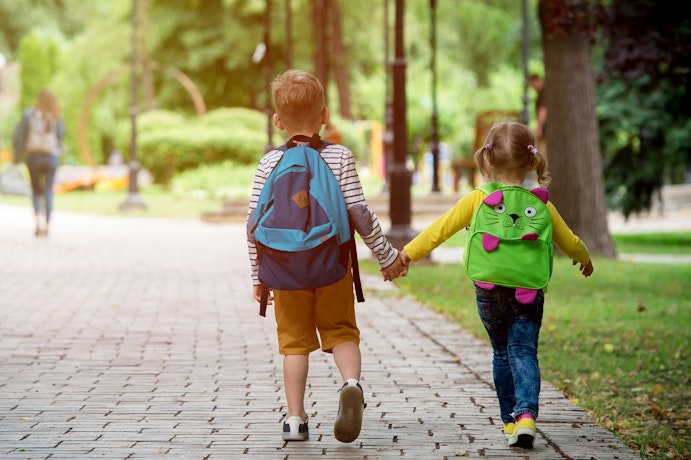The first day of Kindergarten is a huge milestone for little kiddos (and their parents)! It’s an exciting time, but for some families, it comes with anxieties, fears, and mixed emotions. Being dropped off in a new environment filled with new people can be understandably stressful.
Signs Your Child Is Feeling Anxious
Watch for these signs that your little one might be feeling anxious about the start of school:
There’s an increase in meltdowns and acting out. Anxiety manifests in a lot of different ways because it’s based on a physiological response to a perceived threat. Their behavior can be misread as defiance or anger but is really an anxiety response.
They’re having difficulty falling asleep. As the first day approaches, you might find that your child is having trouble falling asleep. They may be needing you more often or for longer periods at night.
Expressing fear or worry about school. Parents are often quick to minimize a child’s fears when they verbally express them, saying things like “It’ll be fun!,” “You’ll make friends quick!” and “There’s nothing to be nervous about!” It’s important to validate and empathize with your child’s feelings.
New onset of stomach aches or headaches. These physical symptoms could mean that your child is struggling with anxiety and may need to see a healthcare professional.
Your own fear and anxiety about your child starting school may affect them as well. Children are very perceptive about their parents’ emotions, and if they see that you’re anxious, they may become anxious too. Be confident and positive without overhyping it.
5 Ways to Calm Your Child's Fears
If you notice that your child is having some fear and worry about the first day of Kindergarten, there are a few things you can do to help calm their anxieties.
1. Get acquainted.
Ask about orientation. If your child’s school offers it, take advantage of the opportunity for you and your child to meet teachers and classmates. If no orientation is offered, it’s a good idea to arrange a tour of a school and a meeting with your child’s teacher before the big day. Help the teacher get to know your child better by preparing a one-page cheat sheet about them, including their name and nickname, photo, medical conditions, likes and dislikes, interests and talents, etc. This will also give the teacher a few conversation starters for building a relationship. If you can arrange for your child to get acquainted with the teacher as well, that’s even better! Forming a relationship with the teacher before school starts will make the separation from you a bit easier. Furthermore, do a little networking with other parents and see if you can set up a playdate with another child in their class. Seeing that familiar face in class will be a comfort and help to ease your child’s nerves.
2. Keep it positive.
When you talk to your child about the upcoming school year and her transition to Kindergarten, remain optimistic and positive. Do not overhype the milestone. Making too big a deal of it may create an uptick in your child’s anxious feelings. As mentioned, validate your child’s emotions and empathize while keeping a general sense of optimism and showing confidence in your little one.
3. Find an anchor.
Some children can skip off to the classroom without so much as a backward glance, but many children experience separation anxiety. For those children, it’s helpful to find an anchor – something that helps them feel close to you while they’re away. A little piece of home away from home. It could be something as simple as a matching necklace, a photo of you, or a note in the lunchbox. An anchor is like a security blanket that your child can take with her every day.
4. Play and practice.
During that meeting with your child’s teacher before school starts, get a good sense of what a typical day will look like and what your child will be doing in the first few weeks of school, and then begin practicing those things over the summer with your child. Doing so will help familiarize your child with the routine and structure of school.
SnuggleBuddies® Help Big Emotions & Meltdowns
Use role play to show her how to introduce herself to others, how to ask to join a group or game, using words to express feelings and wants, and appropriate solutions to conflict. The more you practice, the more confident your child will feel and the better those skills will develop! This will make the transition easier.
In addition to practicing things like standing in line, sitting still, following directions, etc., it’s a good idea to start practicing social-emotional skills as well. Use the Time-In ToolKit to teach about emotions. The Time-In ToolKit® playfully teaches kids 2-9+ how to navigate big emotions through social-emotional skill-building games.
5. Be their safe place.
It may only take your child a few days to adjust to Kindergarten life, or it could take weeks or even months. Every child is different and their experience will be unique. It is unhelpful to compare them to other children in the classroom who seem to be handling it much better. Rest assured that this is a temporary phase, and with the right support, your child will be able to overcome those fears.
Last year, I sent my firstborn off to his first day of high school. HIGH SCHOOL! And it feels like yesterday was his first day at Kindergarten. So if I may be so predictable, it does go by quickly, and before you can blink twice, that Kindergartener will be wanting a driver’s license. Good luck to you all!






















